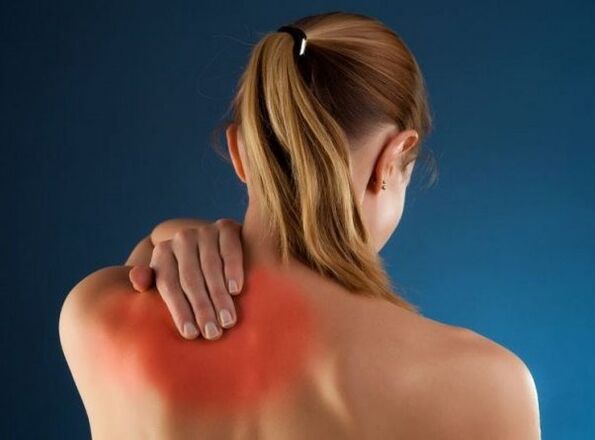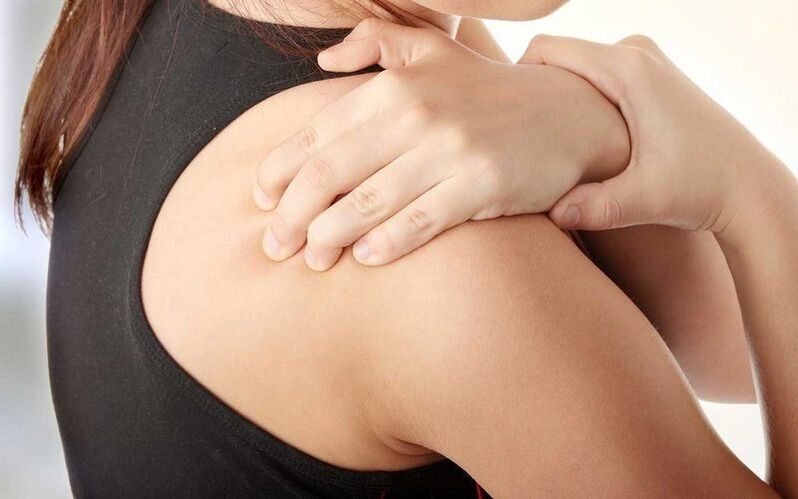
Back pain in the area of the shoulder blades is a very common complaint among patients belonging to a wide variety of age groups. This problem interferes with breathing and creates serious obstacles to physical activity, work, or simple movement.
Patients rarely pay due attention to recurrent pain in the area of the shoulder blades. However, this symptom is a "wake-up call" of serious changes not only in the musculoskeletal system, but also in the internal organo-complex. Such conditions can threaten the patient with disability and death.
Next, we will consider the most common causes of pain in the shoulder blades and modern therapeutic techniques.
The most common reasons
The shoulder blades are located in the back of the back in close proximity to the humerus and clavicle. These paired bones, which are triangular in shape, are part of the skeleton on which the muscles responsible for the mobility of the shoulders are attached. It is for this reason that back pain in the area of the shoulder blades interferes with normal functioning, interferes with performance and is a serious health hazard.
Why does the back hurt in the area of the shoulder blades? According to medical statistics, such problems are most often caused by trauma and damage to the elements of the cervical and thoracic spine. Severe pain syndrome can be observed due to pathological changes provoked by scoliosis or osteochondropathy, as well as the following reasons:
- diseases of the cardiovascular system;
- intercostal neuralgia;
- humeral-scapular periarthritis;
- herniated discs in the thoracic spine;
- deforming spondylarthrosis;
- scoliosis, kyphoscoliosis and other curvature of the spinal column;
- failure of one or two kidneys.
If the back hurts in the area of the shoulder blades, the causes can be in diseases, tumors and injuries of the mediastinal organs, herpes zoster, intercostal neuralgia, impaired liver function, various pathologies of the pleura and lungs, as well as in the long-term performance of monotonous activity on the background of chronic ailments. At risk are drivers, office workers, seamstresses and representatives of other professions associated with a long stay in one position.
Pain in the back on the left and below the shoulder blades
Back pain below the shoulder blades often occurs due to osteochondrosis, various forms of stoop and scoliosis. If a teenager has a disturbed physiological posture, he needs a full diagnosis, well-chosen prevention and therapy. Otherwise, he may develop pathologies and deformities that are difficult to treat and interfere with normal life.
Pain in the spine associated with the causes listed above usually manifests itself in the form of severe discomfort that occurs after physical exertion. It is preferable to treat scoliosis and other curvature of the spinal column through massage, as well as manual and osteopathic effects. Pain syndrome, localized in the region of the shoulder blades on the left, is a serious danger, since such symptoms can indicate an attack of angina pectoris and developing coronary heart disease.
If pain in the left side of the back in the area of the shoulder blades is accompanied by increased fatigue, shortness of breath, weakness and slight swelling of the face and ankles, you should immediately consult a doctor. Another cause of pain to the left of the shoulder blades may be a herniated disc. At risk are people who are forced to be in an uncomfortable position for a long time, driving a vehicle or working at a computer.
If the pain is only slightly annoying, you can limit yourself to using an ointment with a warming or analgesic effect, however, in case of exacerbation, the patient is advised to stay in bed.
Treatment of intervertebral hernia of the thoracic region involves the method of traction traction, manual therapy, reflexology, exercise therapy and a course of therapeutic massage. Medicamentous methods of treating such pathologies are currently unknown to conservative medicine. With surgical intervention, the probability of a positive outcome is relatively small and is about 30-35%.
At the same time, many patients experience relapses after a period of 10 months to several years.
Pain in the muscles of the back under the shoulder blades and in one shoulder blade
Pain in the muscles located between the shoulder blades is usually observed in professional athletes who are engaged in weightlifting and in people who, by the nature of their activities, are faced with high physical exertion. Causes of muscle pain between the shoulder blades can be:
- various injuries and bruises;
- sprained tendons;
- overstrain while working or exercising in the gym.
If one scapula hurts badly, the pathology can be triggered by myopathy, neuroinfection, paralysis of the anterior dentate, trapezius or rhomboid muscles, various deformities of the shoulder joints, tuberculosis of the scapula or osteomyelitis, which led to the development of suppuration and poisoning of the body.
Stomach ulcer
Pain syndrome localized in the area of the shoulder blades often indicates the presence of such a dangerous disease as a stomach ulcer. In this case, discomfort and discomfort can spread along the thoracic spine, giving it to the nipple and scapula, located on the left side. The pain increases gradually and is characterized by seasonality and periodicity, subsiding after emptying the contents of the stomach through the induction of vomiting. In addition, most patients experience symptoms such as belching, salivation, and heartburn.
It is interesting! With perforation of peptic ulcer during even minor activity, the level of discomfort greatly increases, and to get rid of it, the patient has to take a forced position on his back or right side, pressing his hips to the abdomen. This phenomenon is accompanied by increased excitement, attacks of fear, as well as intolerable pain syndrome, which radiates to the area above the collarbone.
Abscesses and muscle spasms of the bile ducts
Cutting and stabbing pain on the right side just below the shoulder blades is often caused by blockage of bile duct stones. As a result, there are colic, severe pain syndrome and the following symptoms:
- the presence of "tearing" sensations in the right hypochondrium;
- sudden pain attack;
- nervousness, irritability;
- pain radiating to the eyes, jaw, neck and right shoulder.
Pain syndrome, localized above the waist in the region of the right shoulder blade, may be due to a subdiaphragmatic abscess, which is characterized by very strong discomfort on inspiration, increased body temperature and pain radiating to the right shoulder. With an inflammatory process in the kidneys (nephritis, pyelonephritis), there is pain in the region of the right shoulder blade and lower back with frequent urination, which causes a number of painful sensations.
Mental problems
Pain in the spine between the shoulder blades are often triggered by various psychological problems. In such a case, discomfort is usually accompanied by the following symptoms:
- feeling short of breath;
- sensation of a lump in the throat;
- paranoid thoughts, unmotivated fear;
- the appearance of cold shivering and heat in the chest;
- feeling of pressure, heaviness and constriction.
In case of mental problems, there is often an unpleasant feeling that the heart "bleeds" or jumps out of the chest, and the back in the area of the shoulder blades also burns. Many patients experience chilling tremors, internal agitation and restlessness, reaching panic attacks.
Intercostal neuralgia and osteochondrosis of the cervical region
Pain localized under the scapula, in the case of intercostal neuralgia, has a paroxysmal girdle character, and intensifies during palpation, exercise, walking and coughing attacks. In some cases, such symptoms are accompanied by excessive muscle tension, there is also a burning sensation, tingling and loss of sensitivity.

With osteochondrosis and Bechterew's disease, the pain syndrome often worsens at night, depriving the patient of sleep and causing great muscle tension in the morning.
With osteochondrosis of the cervical spine, the following symptoms are observed:
- dizziness;
- increased pain in case of sharp flexion or extension of the neck;
- paresthesia in the region of the shoulder girdle;
- pain radiating to the arm or head.
Osteochondrosis can be recognized by unilateral dull pain in the occipital region. Discomfort usually increases in the morning, provoking early awakening and giving the patient a lot of problems. To alleviate an attack of cervical osteochondrosis, a warm bath or various medications are used, which are selected exclusively as directed by a doctor.
During pregnancy
In women during pregnancy, the load on the spinal column increases, therefore, a significant percentage of expectant mothers complain of back pain, including in the area of the shoulder blades. Breaking and burning pains, as well as a feeling of numbness in the area of the shoulder blades, are often associated with changes in the hormonal background, which also affects the aggravation of chronic diseases such as osteochondrosis.
For preventive purposes, some doctors recommend that women use a support corset in the late trimesters of pregnancy, and a bandage after childbirth, which reduces the load on the spine and allows the child to maintain the correct position.
Other reasons
Back pain in the shoulder blades can be caused by angina pectoris or myocardial infarction. The pain syndrome usually occurs against the background of intense physical exertion and has a twisting eversion character. Unpleasant sensations are common throughout the upper left half of the body, and getting rid of them with the help of medicines with a vasodilator effect will not work.
In such a case, it is necessary to eliminate negative symptoms in a clinical hospital, where the patient is prescribed specially selected narcotic analgesics and supportive drugs.
Diagnosis and treatment
Before taking any steps to get rid of the pain syndrome localized in the area of the shoulder blades, it is necessary to establish the cause of the pathology that has arisen. In case of aching pain in the back between the shoulder blades, which is accompanied by pulling and twisting sensations, and it bakes and burns in the chest, you should immediately consult a doctor. The doctor will select the best diagnostic method, such as:
- x-ray of the chest and spine;
- ultrasound;
- electrocardiogram;
- CT scan.
Manual therapy in many cases shows positive results and allows you to strengthen both the lumbar and upper back, as well as make the muscle tissues that support the spinal column more elastic. Osteopathy and reflexology contribute to the activation of regeneration processes and local metabolism. It is worth strengthening muscles regularly by performing an individually selected set of exercise therapy exercises.































